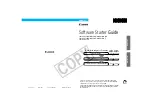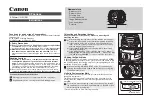
Pike Technical Manual
V5.2.0
217
Controlling image capture
In this case the camera can resynchronize the horizontal clock to the new trigger
event, leaving only a very short uncertainty time of the master clock period.
Sequence mode
Generally all Pike cameras enable certain image settings to be modified on the
fly, e.g. gain and shutter can be changed by the host computer by writing into
the gain and shutter register even while the camera is running. An uncertainty
of up to 3 images remains because normally the host does not know (especially
with external trigger) when the next image will arrive.
Sequence mode
is a different concept where the camera holds a set of different
image parameters for a sequence of images. The parameter set is stored volatile
in the camera for each image to be recorded. This sequence of parameter sets is
simply called a sequence. The advantage is that the camera can easily synchro-
nize this parameter set with the images so that no uncertainty can occur. All Pike
cameras support 32 different sequence parameters.
Additionally to the sequence mode known from Marlin cameras, the Pike cam-
eras have:
•
Repeat counter per sequence item
•
Incrementing list pointer on input status (on/off)
Model
Exposure start jitter
(while FVal)
Exposure start jitter
(while camera idle)
Pike F-032
4.9 μs
375 ns
Pike F-100
8.2 μs
1.65 μs
Pike F-145
16 μs
2.9 μs
Pike F-145-15fps
30 μs
5.4 μs
Pike F-210
14.25 μs
1.8 μs
Pike F-421
15 μs
1.65 μs
Pike F-505
17 μs
5.7 μs
Pike F-1100
single tap:
141 μs
dual tap:
74.5 μs
7.64 μs
(dual tap)
Pike F-1600
single tap:
177 μs
dual tap:
95.7 μs
13.6 μs
(dual tap)
Table 78: Jitter at exposure start (no binning, no sub-sampling)
Note
•
Jitter at the beginning of an exposure has no effect on
the length of exposure, i.e. it is always constant.
















































